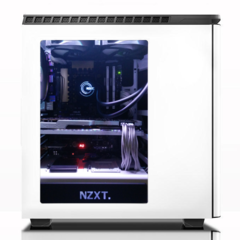Power Supplies
Great Title, Huh? I'm starting with the cardinal rule of writing: write laconicly. (FYI, good, to-the-point writing should never use words like "laconic")
If a CPU is a computer "Brain", the Power Supply Unit (henceforth referred to as PSU) is the heart. It pumps Alternating Current (AC) electricity from a wall socket, converts it to Direct Current (DC) electricity that is then split into various voltages/amperages and sent to a PC's internal components. A truely glorious function, eh?
"So", one may ask, "Why is a glorified AC/DC converter brick come in so many varieties and prices?" Easy: Computers require lots of energy, and they require a very fine tuned source. A good gaming computer draws around 400 watts under load. In comparison, your average CFL lightbulb uses 13 watts. a PSU unit must be able to supply lots of electric energy at any one time. The other condition is that a PSU must supply DC Energy. Now, energy that is converted from AC to DC will have different characteristics than energy that is produced as DC electricity. For basic appliances, like a radio, a small golf-ball sized converter will do. For a computer, more stringent requirements are demanded. While all PC internals are able to handle a little bit of variance, the amount of "ripple" they can tolerate is small. By "ripple", I mean the issue i mentioned earlier: DC current that is "converted" from AC will still have a bit of "wobble" in its polarity. It looks something like this:

Those dotted lines on the graph show what full AC current does. The ripple left over is due to incomplete conversion of the AC current, and will always exist a little, even in the best of power supplies. However, and this is the key, the more expensive ones generally do it better by including what is called power factor correction (PFC). PFC has the major short-term benifit of allowing more internals to draw power with a smaller power draw (in amperes) from the wall.
Now, I'm not saying that ripple will make your computer blow up; as I said earlier, all PC internals can handle it to a degree. However, long term performance of internals can suffer, and in the event of a power surge, that ripple can be magnified, even if the pure power is successfully suppresed by the PSU.
Power Surges bring up my final point. Better PSUs will have a variety of suppression techniques to handle spesific types of surges. This includes both Over and Under Voltage Protection, the latter of which can occur during a "brown-out", which is a sudden large decrease in power coming from the wall outlet to the unit.
This all results in a few things to consider when looking at Power Supply Units:
- Power Supply Units are more than just dumb electric converters.
- Even though both a 50 dollar unit and an 80 dollar unit claim to deliver a continuous 600 watts, the 80 dollar unit will have much better forms of power conditioning and protection.
Now on to the more cosmetic parts: Modularity and Cabling.
Modulartiy is the difference between this:

And This:

Yes. That's it. So why is it a big deal?
Though some may dissagree with me here, I think it has two reasons, both of which are largely cosmetic.
The first is cable management. You will notice that the latter picture appears to be much "cleaner" looking than the former. If you have a non-modular power supply and you don't use all the cables (and you almost certainly won't) the extra cables just have to... sit there looking ugly. Well, they can be pushed into a cable management hole and behind the motherboard, but that often means unnessesary junk and worse overall cable routing. It also means less avalible free space, which can be a premium in smaller builds.
The second is cable quality. With fully modular PSUs, every single cable can be interchanged with any other cable of the correct type. This allows for the purchase of fancy sleeved cables like this one. When you carefully lay out your power cables and conciously select aftermarket cables according to looks, a case can end up looking flat-out awesome.
The end message: Some Power Supplies are better than others. Some power supplies are prettier than others. And while prettier generally equals better, that isn't always the case.
How does one see what is what? How are PSU spesifications listed?
I'd look at three major categories: Current Conditioning / Protection, Internals, and Power Spesifications.
Current Conditioning and Protection is fairly straightforward. Look on sites such as http://www.jonnyguru.com or Tom's Hardware for in-depth analysis of these specs.
Internals can be a mixed bag, but a few good things to see are Single-Rail construction (Well, sometimes...) and all Japanese Capacitors.
Power Spesifications. Hoo-boy. Well, until more recent times, companies listed either Maximum Wattage or Continuous Wattage. Never buy a PSU listed with only maximum wattage. I cannot stress this enough. Maximum wattage can mean literally anything! This is a bad spesification because there is no industry standard for listing this. Continuous wattage is a much more strong spec, and thus you should always shop around for whatever you need in continuous.
Good Luck, and Happy Shopping.
A Note on Brands:
While some folks will tell you to simply "always buy brand X" it isn't nessesarily a rule to end all rules. Some companies (for example, corsair) make both excellent and... not so excellent products. It is best to always look at both the customer reviews on retailer sites such as Newegg.com or Amazon.com, as well as reading up on more in-depth reviews of units on places like jonnyguru.com or linustechtips.com.



0 Comments
There are no comments to display.